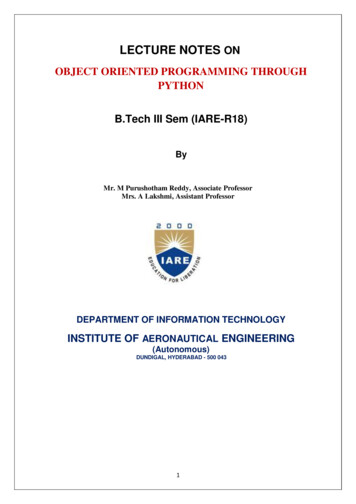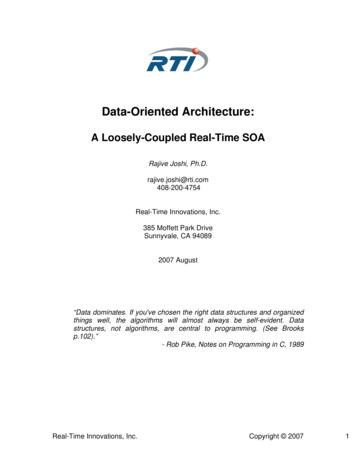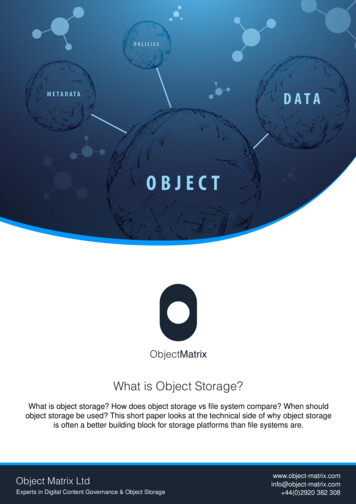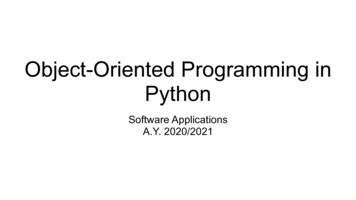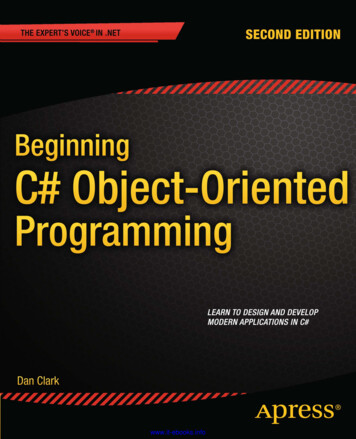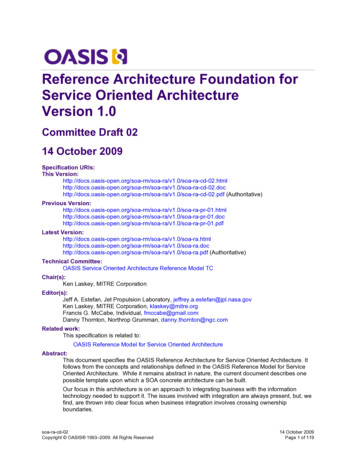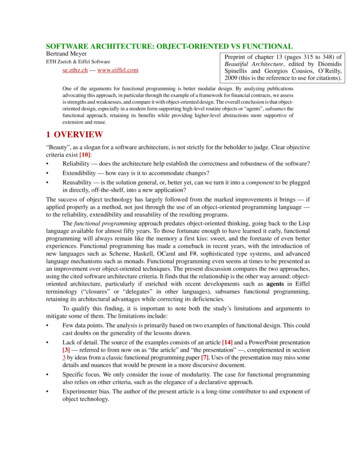
Transcription
SOFTWARE ARCHITECTURE: OBJECT-ORIENTED VS FUNCTIONALBertrand Meyer ETH Zurich & Eiffel Softwarese.ethz.ch — www.eiffel.comPreprint of chapter 13 (pages 315 to 348) ofBeautiful Architecture, edited by DiomidisSpinellis and Georgios Cousios, O’Reilly,2009 (this is the reference to use for citations).One of the arguments for functional programming is better modular design. By analyzing publicationsadvocating this approach, in particular through the example of a framework for financial contracts, we assessis strengths and weaknesses, and compare it with object-oriented design. The overall conclusion is that objectoriented design, especially in a modern form supporting high-level routine objects or “agents”, subsumes thefunctional approach, retaining its benefits while providing higher-level abstractions more supportive ofextension and reuse.1 OVERVIEW“Beauty”, as a slogan for a software architecture, is not strictly for the beholder to judge. Clear objectivecriteria exist [10]: Reliability — does the architecture help establish the correctness and robustness of the software? Extendibility — how easy is it to accommodate changes? Reusability — is the solution general, or, better yet, can we turn it into a component to be pluggedin directly, off-the-shelf, into a new application?The success of object technology has largely followed from the marked improvements it brings — ifapplied properly as a method, not just through the use of an object-oriented programming language —to the reliability, extendibility and reusability of the resulting programs.The functional programming approach predates object-oriented thinking, going back to the Lisplanguage available for almost fifty years. To those fortunate enough to have learned it early, functionalprogramming will always remain like the memory a first kiss: sweet, and the foretaste of even betterexperiences. Functional programming has made a comeback in recent years, with the introduction ofnew languages such as Scheme, Haskell, OCaml and F#, sophisticated type systems, and advancedlanguage mechanisms such as monads. Functional programming even seems at times to be presented asan improvement over object-oriented techniques. The present discussion compares the two approaches,using the cited software architecture criteria. It finds that the relationship is the other way around: objectoriented architecture, particularly if enriched with recent developments such as agents in Eiffelterminology (“closures” or “delegates” in other languages), subsumes functional programming,retaining its architectural advantages while correcting its deficiencies.To qualify this finding, it is important to note both the study’s limitations and arguments tomitigate some of them. The limitations include: Few data points. The analysis is primarily based on two examples of functional design. This couldcast doubts on the generality of the lessons drawn. Lack of detail. The source of the examples consists of an article [14] and a PowerPoint presentation[3] — referred to from now on as “the article” and “the presentation” —, complemented in section3 by ideas from a classic functional programming paper [7]. Uses of the presentation may miss somedetails and nuances that would be present in a more discursive document. Specific focus. We only consider the issue of modularity. The case for functional programmingalso relies on other criteria, such as the elegance of a declarative approach. Experimenter bias. The author of the present article is a long-time contributor to and exponent ofobject technology.
2SOFTWARE ARCHITECTURE: OBJECT-ORIENTED VS FUNCTIONAL §1The following observations counterbalance some of this possible criticism: The functional examples come from industrial practice; specifically, a company whose businessappears to rest on the application of functional programming techniques. The principal example— specifying sophisticated financial instruments — addresses complex problems faced by thefinancial industry, which current tools do not address well according to the presentation’s author,an expert in that industry. This suggests that it is representative of the state of the art. (The firstexample — specifying puddings — is academic, intended only as a pedagogical stepping stone.) One of the authors of the article (S. Peyton-Jones), also acknowledged in the presentation as coauthor of the underlying theoretical work, is the lead designer of the Haskell language and one ofthe most notable figures in functional programming, bringing considerable credibility. The paperused as subsidiary example in section 3 has been extremely influential and was written by anotherleading member of the functional programming community (J. Hughes). In spite of the reservations expressed below, the solutions described in these documents areelegant and clearly the result of considerable reflection. The examples do not exercise the notion of changeable state, which would favor an imperativeobject-oriented programming style.We must also note that mechanisms such as agents, which provide essential ingredients of the full objectoriented solution, were openly inspired by functional programming ideas. So the conclusion will not bea dismissal of the functional school’s contribution, simply the observation that the object-oriented styleis more suited for defining the overall architecture of reliable, extendible and reusable software, whilethe building blocks may involve a combination of O-O and functional techniques.Further observations about the following discussion: Object technology as used here takes the form of Eiffel. We have not attempted to analyze whatremains if one removes mechanisms such as multiple inheritance (absent in Java and C#),genericity (absent in older versions of these languages), contracts (absent outside of Eifffel exceptin JML and Spec#), agent-style facilities (absent in Java); or if one adds mechanisms such asoverloading and static functions, which threaten the power and simplicity of the O-O edifice. The discussion is about architecture and design. In spite of its name, functional programming is(like object technology) relevant to these tasks and not just to “programming” in the restrictedsense of implementation. The Eiffel approach explicitly introduces a continuum fromspecification to design and implementation through the concept of seamless development.Implementation-oriented properties of either approach, while important in practice, will not beconsidered in any detail. Also relevant in practice are issues of expressiveness and notation. They are taken into account tothe extent that they affect the key criteria of architecture and design. For the most part, however,the discussion considers semantics rather than syntax.Two more preliminary notes. First, terminology: by default the term “contract” refers to financialcontracts, relevant to the application domain of the article and presentation, and not to be confused withthe software notion of Design by Contract (the idea [10] of including elements of specification such aspreconditions, postconditions, invariants). In case of possible ambiguity the terms will be financialcontracts and software contracts.
§2 THE FUNCTIONAL EXAMPLES3Second, semi-apology: when the discussion moves to O-O territory in its second half, it includesmore references to and repetitions from the author’s previous publications than discretion would command.The reason is that the wide spread of object technology has been accompanied by the loss of some of itsmore subtle but (in our opinion) critical principles, such as command-query separation (3.5); this makessome brief reminders necessary. For the full rationale behind these ideas, see the cited references.2 THE FUNCTIONAL EXAMPLESThe overall goal of the article and presentation is to propose a convenient mechanism for describing andhandling financial contracts, especially modern financial instruments that can be very complicated, as inthis example from the presentation (in whose numerical values one can hear the nostalgic echo of a timewhen major currencies enjoyed a different relationship):“Against the promise to pay USD 2.00 on December 27 (the price of theoption), the holder has the right, on December 4, to choose between: Receiving USD 1.95 on December 29, or Having the right, on December 11, to choose between- Receiving EUR 2.20 on December 28, or- Having the right, on December 18, to choose between- Receiving GBP 1.20 on December 30, or- Paying immediately one more EUR and receiving EUR 3.20on December 29”(Throughout this section, extracts in quotes are direct citations from the presentation or the article.Elements not in quotes are our interpretations and comments.)As a pedagogical device to illustrate the issues, the presentation starts out with a toy example:puddings rather than contracts. From the precise description of a pudding, it should be possible to“compute the sugar content”, “estimate the time to make” the pudding, obtain “instructions to make it”.A “bad approach” would be to: “List all puddings (Trifle, lemon upside down pudding, Dutch apple cake, Christmas pudding) For each pudding, write down sugar content, time to make, instructions, etc.”Although the presentation does not state why the approach is bad, we can easily surmise the reasons: asa collection of ad hoc descriptions, it has no reusability, since it does not take advantage of the propertythat different kinds of pudding may share the same basic parts; it has no extendibility, since anymodification of a pudding part will require reworking all the puddings that rely on that part.The pudding is a metaphor for the examples of real interest, contracts, but since it is easilyunderstandable without specialized knowledge domain we continue with it. A “good approach” is to: “Define a small set of ‘pudding combinators’. Define all puddings in terms of these combinators. Calculate sugar content from these combinators too.”
4SOFTWARE ARCHITECTURE: OBJECT-ORIENTED VS FUNCTIONAL §2The following tree, from the presentation, illustrates what the combinators may be:(We share the reader’s alarm at the unappetizing nature of the examples, especially coming from a Parisbased author. The sympathetic explanation is that the presentation was directed to a foreign audience ofwhich it assumed, along with unfamiliarity with the metric system, barbaric culinary habits. The presentdiscussion relies on the assumption that bad taste in desserts is not a sufficient predictor of bad taste inlanguage and architecture paradigms.)The non-leaf nodes of the tree represent combinators, applied to the subtrees. For example “Take”is a combinator that assumes two arguments, a pudding part (“Cream” on the left, “Oranges” on the right)and a quantity (“1 pint” and “6”); the result of the application, represented by the tree node, is a puddingpart or a pudding made of the given quantity of the given part.It is also possible to write out such a structure textually, using a mini- “domain-specific language”(DSL) “for describing puddings”:“salad“toppingmain partapple partorange part on top of topping main part” whipped (take pint cream) mixture apple part orange part chopped (take 3 apple) optional (take 6 oranges)”-- Changed from “OnTopOf” for consistency(Boldface added for operators.) This uses an anonymous but typical — the proper term might be vanilla— variant of functional programming notation, where function application is simply written asfunction args, for example plus a b for the application of plus to a and b, and parentheses serve onlyfor grouping.With this basis, it becomes a piece of cake to define an operation such as sugar content by caseanalysis on the combinators (similar to defining a mathematical function on recursively defined objectsby using a definition that follows the same recursive structure):“S(on top of p1 p2)S(whipped p)S(take q i)etc.” S (p1) S (p2) S (p) q S(i)
§3 ASSESSING THE MODULARITY OF FUNCTIONAL SOLUTIONS5Not clear (to us) from the “etc.” is how operators such as S deal with the optional combinator; there hasto be some way of specifying whether a particular concoction has the optional part or not. This issueaside, the approach brings the benefits that the presentation claims for it: “When we define a new recipe, we can calculate its sugar content with no further work. Only if we add new combinators or new ingredients would we need to enhance S.”The real goal is of course not pudding but contracts. Here the presentation contains a sketch of theapproach but the article is more detailed. It relies on the same ideas, applied to a more interesting set ofelements, combinators and operations.The elements are financial contracts, dates, observables (such as a certain exchange rate on acertain date). Examples of basic contracts include zero (can be acquired at any time, no rights, noobligations) and one (c) for a currency c (immediately pays the holder one unit of c).Examples of combinators on contracts include: or, such that acquiring the contract (or c1 c2)means acquiring either of c1 and c2, and expiring when both have expired; anytime, such that(anytime c) can be acquired at any time before the expiration of c, and expiring whenever c expires;truncate, such that (truncate t c) is like c except that it expires at the earlier of t and the expiry of t; andget, so that acquiring (get c) means acquiring c at its expiry date. The paper lists about a dozen such basiccombinators on contracts, and others on observables and dates. They make it possible to define advancedfinancial instruments such as a “European option” in a simple way:european t u get (truncate t (or u zero))Operations include the expiry date of a contract and — the most important practical benefit expectedfrom all this modeling effort — its value process, a time-indexed sequence of expected values. As withthe sugar content of a pudding, the functions are defined by case analysis on the basic constructors. Hereare the cases involving the preceding basic elements and combinators for the operation H, which denotesthe expiry date or “horizon”H (zero)H (or c1 c2)H (anytime c)H (truncate t c)H (get c) -- Where is a special value with the expected propertiesmax (H (c1), H (c2)H (c)min (t, H (c)H (c)The rules yielding value processes follow a similar structure, although the right-hand sides are moresophisticated, involving financial and numerical computations.3 ASSESSING THE MODULARITY OF FUNCTIONAL SOLUTIONSThe preceding presentation, while leaving aside many contributions of the presentation and especiallythe article, suffices as a basis for discussing architectural features of the functional approach andcomparing them with the O-O view. We will freely alternate between the pudding example (which makesthe ideas immediately understandable) and financial contracts (representative of real applications).
6SOFTWARE ARCHITECTURE: OBJECT-ORIENTED VS FUNCTIONAL §33.1 Extendibility criteriaAs pointed out by the presentation, the immediate architectural benefit is that it is easy to add a newcombinator: “When we define a new recipe, we can calculate its sugar content with no further work”.This property, however, is hardly a consequence of using a functional programming approach. Theinsight was to introduce the notion of combinator, which creates pudding and pudding parts — orcontracts — from components that can either be atomic or themselves result from applying combinatorsto more elementary components.The article and presentation suggest that this is a new idea for financial contracts. If so, the insightsshould be beneficial to financial software. But as a general software design idea they are not new.Transposed to the area of GUI design, the “bad approach” rejected at the beginning of the presentation(list all pudding types, for each of them compute sugar content etc.) would mean devising every screenof an interactive application in its own specific way and writing the corresponding operations — display,move, resize, hide — separately in each case. No one ever does this. Any GUI design environmentprovides atomic elements, such as buttons and menu entries, and operations to combine them recursivelyinto windows, menus and other containers to make up a complete interface. Just as the puddingcombinators define the sugar content and calorie count of a pudding from those of its ingredients, andcontract combinators define the horizon and value sequence of a complex contract from those of itsconstituents, the display, move, resize and hide operations on a composite figure apply these operationsrecursively on the components. The EiffelVision library [8] is an example application of thiscompositional approach, systematic but hardly unique. The article’s contribution here is to apply theapproach to a new application area, financial contracts. The approach itself, however, does not assumefunctional programming; any framework with a routine mechanism and recursion will do.Interesting modularity issues arise not when existing combinators are applied to components ofexisting types, but when the combinators and component types change. The presentation indeed states:“Only if we add new combinators or new ingredients would we need to enhance S” (the sugarcombinator). The interesting question is how disruptive such changes will be to the architecture.The set of relevant changes is actually larger than suggested: Along with changes in atomic types and combinators we should consider changes in operations:adding a calorie count function for puddings, a delay operation for contracts, a rotate operation forgraphical objects. Besides such additions we should include changes and removal, although for simplicity thisdiscussion will continue to consider additions only.3.2 Assessing the functional approachThe structure of the programs as given is simple: a set of definitions of the formO (a) O (c (x, y, .) ba,Ofc,O (x, y, .)[1][2]
§3 ASSESSING THE MODULARITY OF FUNCTIONAL SOLUTIONS7for every operation O, atomic type a and basic combinator c; the right-hand sides involve appropriateconstants b and functions f. Again for simplicity, we may view the atomic types such as a as 0-arycombinators, so that we only need to consider form [2]. With t basic combinators and f operations, weneed t f definitions.Regardless of the approach, these t f elements will have to be accommodated. The architecturalproblem is how we group them into modules to facilitate extension and reuse. This issue is not discussedin the article and presentation. Of course the matter is not critical for small t and f ; then all the definitionscan be packed into a single module. This takes care of extendibility in a simple way: To add a basic combinator c, add f definitions of the above form, one for each existing operation. To add an operation O, add t definitions, one for each existing combinator.This approach does not scale well: for larger developments, it will be necessary to divide the system intomodules; the extendibility problem then becomes how to make sure that such modifications affect as fewmodules as possible.Even with fairly small t and f, the one-module solution does not support reusability: if anotherprogram only needs a subset of the operations and combinators, it would suffer the usual dilemma ofprimitive modularization techniques: Charybdis: copy-paste the relevant parts, but then risk forgetting to update the derived moduleswhen something changes in the original (possibly for such prosaic reasons as a bug fix). Scylla: use a module inclusion facility, as provided by many languages, to make the contents ofan existing module available to a new one; but you end up loaded with a bigger baggage thannecessary, which complicates updates and may cause conflicts (assuming the derived moduledefines a new combinator or function and a later version of the original module introduces aclashing definition.)These observations remind us in passing that reusability is closely connected to extendibility. An onlinecritique of the OCaml functional language [17] takes a concrete example:You cannot easily modify the behavior of a module outside of it. Suppose you use a Timemodule defining Time.date of string, which parses ISO8601 basic format("YYYYMMDD"), but want to recognize ISO8601 extended format ("YYYY-MM-DD").Tough luck: you have to get the module maintainer to edit the original function — youcannot redefine the function yourself in your module.As software grows and changes, another aspect of reuse becomes critical: reuse of common properties.Along with European options, the article introduces “American options”. Described as combinators, theyhave different signatures (Date Contract Contract and (Date, Date) Contract Contract), andall the operations have to be defined separately for each of the basic combinators each of them involves.One suspects, however, that the two kinds of option have a number of properties and operations incommon, in the same way that puddings can be grouped into categories. Such groupings would helpmodel and modularize the software, with the added benefit — if enough commonalities emerge — ofreducing the number of required definition to substantially less than t f. This requires, however, takinga new look at the problem domain: we must discover, beyond functions, the essential types.
8SOFTWARE ARCHITECTURE: OBJECT-ORIENTED VS FUNCTIONAL §3Such a view will be at a higher level of abstraction. One can argue in particular with the fixationon functions and their signatures. According to the article (italics retained), “An American option offersmore flexibility than a European option. Typically, an American option confers the right to acquire anunderlying contract at any time between two dates, or not to do so at all.” This suggests a definition byvariation: either American options are a special case of European option, or they are both variants of amore general notion of option. Defining them as combinators immediately sets them apart from eachother because of the extra Date in the signature. This is akin to defining a concept by its implementation— a mathematical rather than computer implementation, but still implying loss of abstraction andgenerality. Using types as the basic modularization mechanism, as in object-oriented design, will elevatethe level of abstraction.3.3 Levels of modularityAssessing functional programming against criteria of modularity is legitimate since bettermodularization is one of the main arguments for the approach. We have seen the presentation’scomments on this issue, but here is a more general statement from one of the foundational papers offunctional programming, by Hughes [7], stating that with this approach:[Programs] can be modularized in new ways, and thereby greatly simplified. This is the keyto functional programming’s power — it allows greatly improved modularization. It is alsothe goal for which functional programmers must strive — smaller and simpler and moregeneral modules, glued together with the new glues we shall describe.The “new glues” described in Hughes’s paper are the ones we have seen at work for the two examplescovered — systematic use of stateless functions, including high-level functions (combinators) which acton other functions — plus the extensive use of lists and other recursively defined types, and the conceptof lazy evaluation.These are attractive techniques, but they address fine-grain modularization. Hughes develops afunctional version of the Newton-Raphson computation of the square root of a number N with toleranceeps and initial approximation a0:sqrt a0 eps N within eps repeat (next N) a0)with appropriate combinators within, repeat and next, and compares this version with a Fortranprogram involving goto instructions. Even ignoring the cheap shot (at the time of the paper’s originalpublication Fortran was already old hat and gotos despised), it is understandable why some people mayprefer such a solution, based on small functions glued through combinators, to the loop version. Thenagain others prefer loops, and because we are talking about the fine-grain structure of programs ratherthan large-scale modularization the issue hardly matters for software engineering; it is a matter of styleand taste. The more fundamental question of demonstrating correctness has essentially the samedifficulty in both approaches; note for example that the definition of within in Hughes’s paper, yieldingthe first element of a sequence that differs from the previous one by less than epswithin eps ([a:b:rest]) if abs (a – b) eps then b else within eps ([b:rest]
§3 ASSESSING THE MODULARITY OF FUNCTIONAL SOLUTIONS9seems to assume that the distances between adjacent elements are decreasing, and definitely assumes thatone of these differences is no greater than eps. Stating this property would imply some Design-byContract-like mechanism to associate preconditions with functions (there is no such mechanism incommon functional approaches); the proof that it guarantees termination of eps would be essentially thesame as a proof of termination for the corresponding loop in the imperative style.There seems to be no contribution to large-grain modularity or software architecture in this andearlier examples. In particular the stateless nature of functional programming does not seem (positivelyor negatively) to affect the issue.In citing examples from Hughes’s paper we have, with his agreement, used modern (Haskell) notation forlists as in [a:b:rest], more readable than the original’s cons notation as in cons a (cons b rest).3.4 The functional advantageThere remains three significant advantages for the functional approach as illustrated in examples so far.The first is notational. No doubt some of the attraction of functional programming languagescomes from the terseness of definitions such as the above. This needs less syntactical baggage thanroutine declarations in common imperative languages. Several qualifications limit this advantage: In considering design issues as in the present discussion, the notational issue is less critical. Onecould, for example, use a functional approach for design then target an imperative language. Many modern functional languages such as Haskell and Ocaml are strongly typed, implying thenotation will be a little more verbose; for example, unless the designer wants to rely on typeinference (not a good idea at the design stage), within needs the type declarationDouble [Double] Double. Not everyone may be comfortable with the common practice — not required by functionalprogramming, but pervasive — of replacing multi-argument functions by functions returningfunctions (known in the medical literature as RCS, for “Rabid Currying Syndrome”, andillustrated by such signatures as (a b c) Obs a Obs b Obs c in the financial article).Still, notation conciseness is a virtue even at the design and architecture level, and functionalprogramming languages may have some lessons here for other design notations.The other two advantages are of a more fundamental nature. One is the ability to manipulateoperations as “first-order citizens” — the conventional phrase, although we can simply say “as objectsof the program” or just “as data”. Lisp first showed that this could be done effectively; a number ofmainstream languages offered a way to pass routines as arguments to other routines, but this was notconsidered a fundamental design technique, and was in fact sometimes viewed with suspicion asreminiscent of self-modifying code with all the associated uncertainties. Modern functional languagesshowed the benefit of accepting higher-order functionals as regular program objects, and developed theassociated type systems. This is the part of functional programming that has had the most direct effecton the development of mainstream approaches to programming; as will be seen below, the notion ofagent, directly derived from these functional programming concepts, is a welcome addition to theoriginal object-oriented framework.
10SOFTWARE ARCHITECTURE: OBJECT-ORIENTED VS FUNCTIONAL §3The third significant attraction of functional programming is lazy evaluation: the ability, in somefunctional languages such as Haskell, to describe a computation that is potentially infinite, with theunderstanding that any concrete execution of that computation will be finite. The above definition ofwithin assumes laziness; this is even more clear in the definition of repeat:repeat f a [a : repeat f (f a))]which produces (in ordinary function application notation) the infinite sequence a, f (a), f (f (a)). Withnext N x defined as (x N / x) / 2, the definition of within as used by sqrt will stop evaluating thatsequence after a finite number of elements.This is an elegant idea. Its general application in software design calls for two observations.First, there is the issue of correctness. The ease of writing potentially infinite programs may maskthe difficulty of ensuring that they will always terminate. We have seen that within assumes aprecondition, not stated in its presentation; that precondition, requiring that elements decrease to beloweps, cannot be finitely evaluated on an infinite sequence (it is semi-decidable). These are trickytechniques for designers to use, as illustrated by the problem of how many functional programmers ittakes to change a light bulb. (It is hard to know in advance. If there are any functional programmers left,ask one to change the bulb. If she fails, try the others.)Second and last, lazy manipulation of infinite structures is possible in a non-functional designenvironment, without any special language support. The abstract data type approach (also known asobject-oriented design) provides the appropriate solution. Finite sequences and lists in Eiffel libraries areavailable through an API relying on a notion of “cursor”:before1afterindexcountLi
oriented design, especially in a modern form su pporting high-level routine objects or "agents", subsumes the functional approach, retaining its benefits while providing higher-level abstractions more supportive of extension and reuse. 1 OVERVIEW "Beauty", as a slogan for a software architecture, is no t strictly for the beholder to judge.
